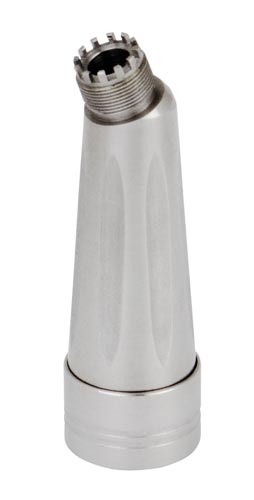Part 2: Attachments for Slow-speed Handpieces
There are 2 basic types of handpiece attachments used with slow-speed motors: nosecones and contra angles.
Nosecone Handpiece Attachments
A nosecone is a straight attachment that accepts a slow-speed bur or a shaft-driven angle (contra angle or prophy angle). Nosecones are unique and come with different gear ratios. The default is a 1:1 ratio – the nosecone operates at the same speed as the motor. Ratio 4:1 is a common gear reduction, the nosecone spins at ¼ the speed of the motor. Some nosecones (primarily those designed for use with electric motors) also have speed increasing gears. They operate at a 1:5 gear ratio (for example) or 5 times the output speed of the motor.
Nosecones are standardized, so they all accept the same diameter bur or shaft driven attachment. They incorporate a pin of some sort to prevent rotation of any shaft driven attachment on the nosecone. All shaft driven attachments have a groove that slides over this pin.
Nosecones accept a slow-speed bur, so all you need to perform a particular procedure may be a motor and nosecone (and bur, of course).
Contra Angles
The other type of attachment, a contra angle, works with gear driven attachments only (most commonly some sort of head). They do NOT accept a bur, so further attachments are required. As the name implies, a contra angle provides an angle for the next attachment which can improve intra-oral access.
Both Midwest and E-type contra angles accept the same type of gear driven heads. The heads incorporate a drive shaft with a gear at the end that seats into the contra angle meshing with the internal drive shaft causing the head to spin. The drive gear has pointed teeth making it easier to seat the two halves together. The head also has square “teeth” under a threaded collar that mesh with the square “teeth” on the outside of the contra angle. These teeth hold the head onto the contra angle and prevent the entire head from spinning (so only the drive shaft spins). It is these teeth that one must count to determine compatibility between a head and contra angle. Heads and contra angles come with either 12 or 14 locking teeth.
Star systems do not normally use a contra angle attachment. Instead, they use a straight attachment that accepts a Star-specific head. Star heads have an elbow incorporated at the end to provide the angle normally provided by a contra angle attachment as used by other systems.
 American Dental Accessories, Inc. also has an after-market contra angle that will work with a Star-type motor. This angle allows you to use standard heads with your Star system (saves you money over the more costly Star-specific heads).
American Dental Accessories, Inc. also has an after-market contra angle that will work with a Star-type motor. This angle allows you to use standard heads with your Star system (saves you money over the more costly Star-specific heads).

Regardless of system, a contra angle (or angle attachment) requires a 3rd attachment for use with a rotary instrument and will not be a complete set-up for a given procedure (as a motor and nosecone alone can be).
Head Attachments
Finally, there are heads. As mentioned above, heads will have both drive teeth and attachment teeth (or drive teeth and a threaded elbow). The number of attachment teeth will determine compatibility with a particular contra angle. The head will accept the rotary instrument with which one will perform a given procedure. The most common head is a latch head which will accept a latch (or RA, for “Right Angle”) bur. RA burs have a groove at the end into which the latch of the head will secure holding the bur in. Some heads also accept standard friction grip burs, exactly as used in a high-speed handpiece.
Other heads only accept prophy cups. Prophy cups can come with either a threaded “screw on” shaft or that simply “snap on” a knob designed for this purpose. Some are also attached to a standard latch-type shaft so they’ll work in a standard latch head.
PHOTO: Snap-on, Screw-on, and Latch-type Prophy Brush & Cups
The flexibility afforded by the various head configurations allows for a tremendous range of applications for a slow-speed set-up. This flexibility can allow for great value with a slow-speed system.




LEAVE A REPLY